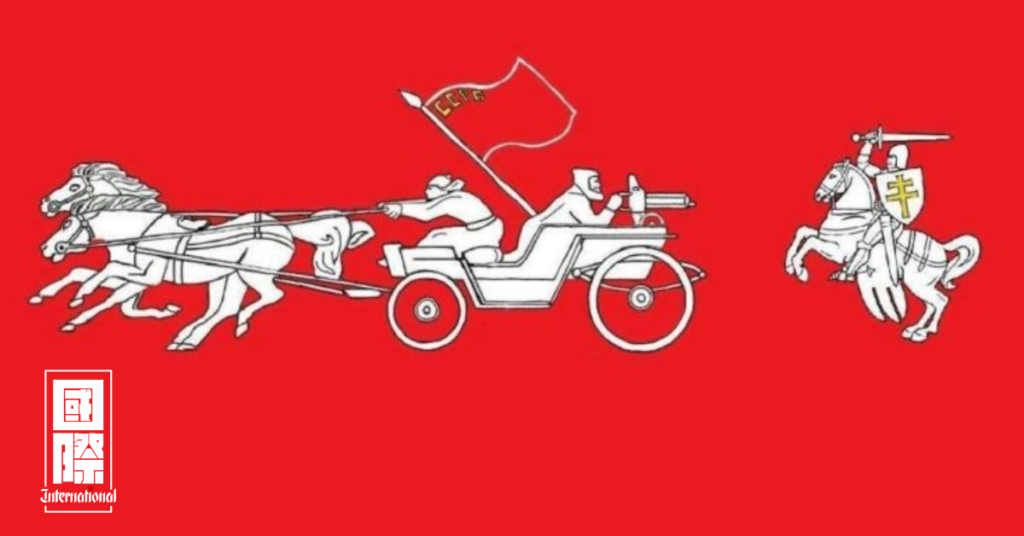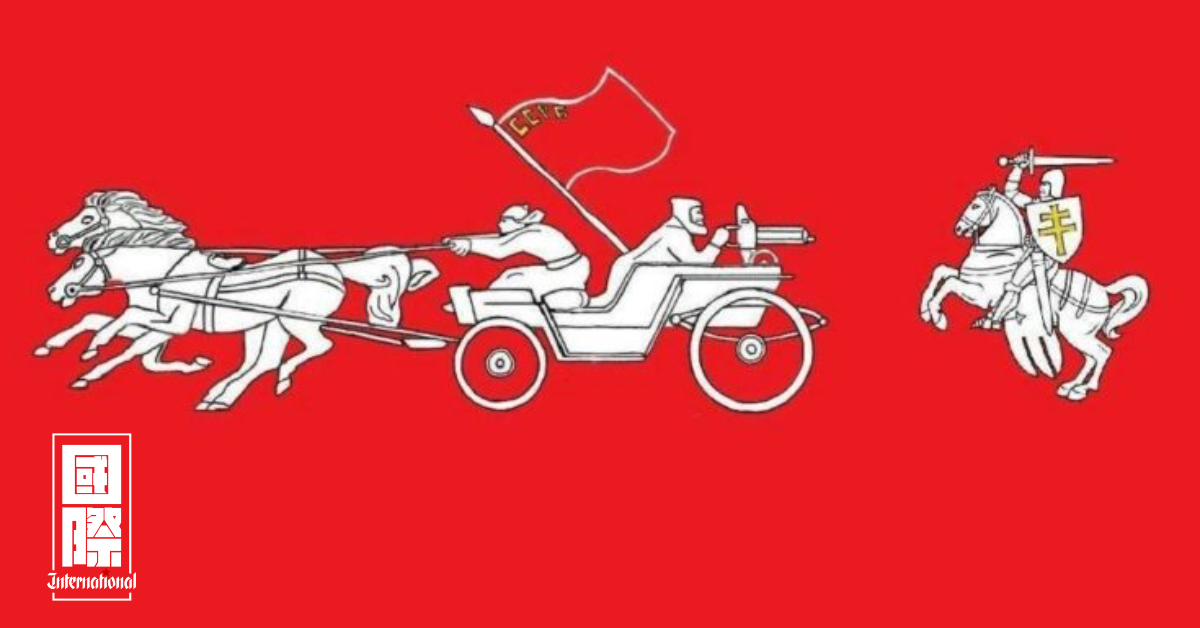
編按:本文譯自烏克蘭左派團體鬥爭派在2020年8月25日發表的聲明的英譯本。英譯者為格雷格·巴特菲爾德(Greg Butterfield),英譯本標題為《The working class should put an end to the Belarusian crisis》。
August 25: The political crisis in the Republic of Belarus has continued for two weeks. The reason was the latest presidential election, the official results of which (the victory of the incumbent President Alexander Lukashenko with 80 percent) categorically did not suit the opposition. Thousands of rallies were held throughout the country. In the early days of the protest, the security forces responded with brutal force. Despite the fact that the protesters failed to achieve their goal — removing President Lukashenko from power — the confrontation continues.
8月25日:白俄羅斯共和國的政治危機已經持續了兩個星期。以反對派徹底否定官方公布的總統選舉結果(現任總統盧卡申科得票八成獲勝)為觸發點,白俄羅斯全國各地舉行了數以千計的示威集會。在抗議運動的頭幾天,保安部隊實行無情的暴力鎮壓。儘管反對派沒有成功驅趕盧卡申科總統下台,雙方仍在對峙。
Lukashenko’s government
盧卡申科的政府
Belarus differs from other post-Soviet countries — Russia, Ukraine, Moldova — in that the permanent President Lukashenko, who came to power in 1994, did not permit mass privatization and destruction of social infrastructure. Most of the large enterprises remain state-owned. Agriculture enjoys state support and provides jobs for a significant part of the country’s population.
白俄羅斯與俄羅斯、烏克蘭和摩爾多瓦等前蘇聯加盟國的不同之處,在於在1994年上台的「永遠的總統」盧卡申科,並沒有容許大規模私有化和消滅社會基本保障。大部分大企業仍然是國有企業,國家支持的農業為白俄羅斯不少人提供了就業。
The cost of economic and social stability was a severe suppression of opposition. However, thanks to these economic and social policies, Lukashenko’s support has rarely dropped below 60 percent before.
經濟和社會穩定的另一面是政府對反對派的嚴厲打壓。儘管如此,這些經濟和社會政策還是讓盧卡申科曾經長年獲得至少六成民眾的支持。
In 2019-2020, the situation in Belarus worsened. The global recession has affected the economy of Belarus. Economic difficulties have intensified with the COVID-19 epidemic.
在2019-2020年期間,白俄羅斯的情況開始惡化。 全球衰退影響了白俄羅斯的經濟,新冠疫情進一步加深了經濟的困難。
It should be noted that in recent years the Lukashenko regime has taken a number of anti-social measures: a tax on “parasites,” reform of labor laws, and some others. However, these decisions were less likely than in Ukraine or Russia to “rob” the majority of workers. The resources obtained from the reduction of the “social sphere” went to state needs, and not into the pockets of oligarchs and officials, as is the case in other post-Soviet countries.
應當指出,盧卡申科政權近年來實行了若干反社會的政策:如向「寄生蟲」【譯注:指有勞動能力而靠國家救濟過活的群體】徵稅,修改勞動法等等。然而,與烏克蘭或俄羅斯相比,白俄羅斯這種決策相對不會「搶劫」大多數的勞動者。因為白俄羅斯從「社會領域」削減的資源投向了其它的國家需要,而不是像其它的前蘇聯加盟國一樣,落入寡頭和官員的口袋之中。
It is also necessary to emphasize the smooth ideological turn of the Lukashenko regime in recent years: fearing absorption by Russia, nationalistic motives were increasingly woven into the state ideology, a policy of “Belarusianization” was pursued and the soft expulsion of the Russian language from the public sphere was carried out.
人們也要重視盧卡申科政權近年來圓滑的意識形態轉向:因害怕被俄羅斯吞併,越來越多的民族主義主題被編進國家意識形態;政府推行了「白俄羅斯化」和用軟性手段從公共領域排斥俄羅斯語的政策。
Against this background, there was a serious deterioration in relations between Belarus and Russia, its main economic partner and political ally. In response to Russian demands for deeper integration and merger into a single state, Lukashenko used the rhetoric of national sovereignty and effectively blocked closer unification. In turn, Russia began to apply pressure by raising the price of energy.
在此背景下,白俄羅斯與其主要的經濟夥伴和政治盟友俄羅斯的關係嚴重惡化。面對俄羅斯提出的深化融合和建立統一國家的要求,盧卡申科動用了國家主權的話語並在實際上阻止了走向統一的步伐。俄羅斯則進而開始通過提高能源價格施壓。
The nature of the protests
示威的性質
The picture of the confrontation between the “people” and the “dictator” imposed by the imperialist media should not overshadow a political and class analysis. Sympathy for the victims of police brutality does not mean supporting their political agenda.
帝國主義媒體強加的「人民」與「獨裁者」之間的對立的景象,不應壓倒政治和階級分析。同情警察暴力的受害者,並不意味著支持他們的政治議程。
The leading force in the protests against the Lukashenko regime was the urban middle class, which has grown and strengthened during the years of relative economic prosperity. The middle class considered the framework of the paternalistic welfare state to be restrictive, seeing its ideal in the “free market” and “free enterprise.” Having no experience of neoliberal reforms that have destroyed the economies of Ukraine and Russia, a significant part of the Belarusian people sees the future of their country in market-driven “freedom.”
在此前經濟相對繁榮的時期內發展壯大的城市中產階級,是反對盧卡申科政權的抗議運動的領導力量。以「自由市場」和「自由企業」為理想的中產階級認為,家長式的福利國家束縛了他們的手腳。由於沒有親歷摧毀了烏克蘭和俄羅斯的經濟的新自由主義改革,為數不少的白俄羅斯人民把市場主導的「自由」視為國家的未來。
However, a neoliberal program of large-scale privatization, health cuts and freedom to lay off workers is unlikely to appeal to most workers. That is why the “reform” program, initially widely advertised by opposition candidate Svetlana Tikhanovskaya and her supporters, was later simply hidden. But it was too late.
然而,大規模私有化、裁減公共醫療和自由解僱工人的新自由主義綱領,並不可能吸引大多數的勞動者。正因如此,反對派總統候選人斯維特拉娜·季哈諾夫斯卡婭(Svetlana Tikhanovskaya)在選戰開始時曾大力宣揚的「改革」綱領,後來就乾脆被下架。但這個動作來得太遲了。
The position of secession from the Union State [of Russia and Belarus, founded in 1996], as well as the dominance of nationalist bloggers and journalists in the Opposition Coordinating Council, alienated broad strata of the population from the protest movement.
脫離1996年成立的俄羅斯和白俄羅斯聯盟的主張,還有民族主義博主和記者們控制「反對派協調委員會」的事實,都讓白俄羅斯各大階層的民眾與抗議運動保持距離。
At the symbolic level, the “white-red-white” nationalist flag, which was also used by Belarusian collaborators during the Second World War, dominates in the protests.
抗議運動的象徵,是二戰期間白俄羅斯納粹分子都用過的「白紅白」民族主義旗幟。
In the absence of prominent leaders, political émigrés controlled by the CIA’s Radio Liberty and the Polish government became the center of control of the protests. Thus, the widespread protest movement was utilized by liberal-nationalist politicians under the control of imperialism, which makes it possible to draw some parallels with the Euromaidan events in Ukraine.
由於抗議運動在白俄羅斯國內沒有突出的領導人,美國中情局自由電台控制的政治流亡分子和波蘭政府成為了運動的指揮中心。因此,帝國主義控制的自由派民族主義政客集團操控了散布各地的抗議運動,使其與烏克蘭親歐事變有若干的相似性。
In response to mass protests, Lukashenko began mobilizing his supporters. Although rallies in support of the president were less massive than opposition rallies, they did not have the character of paid extras, as was often the case with [deposed Ukrainian President] Yanukovych. Lukashenko was supported by older people who have a negative experience of the collapse of the USSR and appreciate the remnants of the welfare state preserved in Belarus.
為應對群眾抗議,盧卡申科開始動員自己的支持者。僅管支持總統的示威集會不及反對派集會人多勢眾,但它們並不是被趕下台的烏克蘭前總統亞努科維奇所往往訴諸的、充斥臨時演員的東西。那些對於蘇聯崩潰有負面的經歷和肯定白俄羅斯保存福利國家遺產的比較年長的群眾,是盧卡申科的支持者。
The role of the working class
工人階級的角色
Unexpectedly for many, an important factor in Belarusian politics was the working class of large enterprises, which actually acted as a separate “party” to the conflict. It was for the allegiance of the working class that the main struggle between Lukashenko and the opposition unfolded.
出乎不少人的意料,大企業工人階級成為了白俄羅斯政局的一個重要因素;他們實際上在這場衝突中自成了一個「陣營」。盧卡申科同反對派之間的主要鬥爭,就是為爭奪工人階級的支持而展開的。
Outraged by the police brutality of the early days of the protests, the working class began to lean towards the opposition. Demands to stop the beatings and to release those arrested found support from the workers. Sensing this, the opposition declared a national strike. However, by that time the harsh crackdown on the protesters had stopped, and most of those arrested were released. While sympathizing with those arrested, the working class was not at all ready to support the political agenda of the protest leaders — privatization, market reforms, nationalism — and the plan to rouse the workers for a nationwide strike actually failed.
在抗議運動的頭幾天,被警察暴行激怒的工人階級一度傾向於反對派。要求當局停止暴行和釋放被捕人員的訴求,得到了部份工人的支持。察覺到了這種氛圍的反對派宣布舉行全國總罷工。然而,到那個時候,政府已經停止了嚴打示威者,也釋放了大部分被捕人員。工人階級儘管同情被捕人員,但完全沒有打算支持運動領袖的私有化、市場改革和民族主義的政治議程。反對派煽動工人舉行全國罷工的計劃徹底失敗了。
The opposition, in turn, deliberately focused on recruiting workers exclusively from state-owned enterprises into the ranks of the strikers in order to inflict maximum economic damage to the “Lukashenko regime.” At the same time, the leaders of workers’ protests associated with the opposition leadership voiced only political slogans; the social agenda was promoted exclusively by representatives of the left-wing organizations of the Republic of Belarus. Along with demands for the abolition of fixed-term labor contracts, leftist activists opposed the privatization of state-owned enterprises. These slogans naturally conflicted with the general trend of the liberal-nationalist agenda and were de facto banned from the main opposition media sources.
為了對「盧卡申科政權」施加最大的經濟打擊,反對派繼而故意重點專門鼓動國有企業工人參加罷工。與此同時,與反對派領導層有聯繫的那些工人抗議活動的帶頭人們,只提出了政治口號;而白俄羅斯共和國的各個左翼組織則包攬了社會訴求。左翼積極分子們除了要求廢除固定期限勞動合同外,也反對私有化國有企業。這些左翼口號自然地與自由派民族主義議程的總傾向格格不入,事實上也被反對派的主要媒體封殺。
However, theses about the “rising labor movement” were actively broadcast outside the Republic and served as an excuse for supporting the white-red-white protests for many left-wing and democratic organizations outside Belarus. It can be stated that the real labor movement, thanks to skillful manipulation, served as a screen for the liberal-market movement led by leaders of the pro-Western opposition. Such examples are well known in history: for example, the protest of freight carriers in Chile against the Allende government in 1972-1973, and the protest of miners in 1991 in the USSR.
儘管如此,各種關於「工運蓬勃發展」的說法還是被大肆對外宣傳,並成為白俄羅斯國外不少左翼和民主團體支持白紅白抗議運動的藉口。 應當指出,即使是真實的工人運動,在精巧的操控之下,也會成為掩護親西方反對派領導的自由派市場運動的煙幕。1972至1973年間反對阿連德政府的智利卡車工人抗議和1991年蘇聯煤礦工人的抗議運動,就是廣為人知的兩個歷史實例。
Borotba welcomes the attempts of the Belarusian left to organize an independent political movement of the working class. But the elimination of the paternalistic state and the implementation of market reforms cannot be an option for Belarus. On the contrary, the strengthening of the social character of the state and the introduction of truly socialist elements into public life can become a way out and an alternative to the lifelong rule of Alexander Lukashenko. And this development is impossible without a strong left movement and independent organizations of the working class.
鬥爭派支持白俄羅斯左翼努力組織工人階級的獨立政治運動。但我們必須指出,所謂消滅家長式國家和推行市場改革,對白俄羅斯來說是死路一條。恰恰相反,只有加強國家的社會性質和在公共生活中投入真正的社會主義元素,才足以成為亞歷山大·盧卡申科的終身統治之外的選擇和出路。沒有強大的左翼運動和工人階級的獨立組織,這種發展是絕不可能的。

像白俄羅斯或香港這樣的「小國」或「地區」,其實只是大國較量之間的棋子。 美國自從大小布殊開始軍事介入中東,直到現在的顏色革命,都是只顧「推翻」而忽略了「重建」,所以人們逐漸不相信顏色革命。 同時也是東西方之間冷戰的「鐘擺效應」,中國現在正享受著一個 winning streak,但中國內部仍然有很多問題暫時被掩蓋。
香港建制派只是中國的傀儡,當中國不再那麼給力地支撐香港,建制派就會「退潮裸泳」。 所以香港的出路是要尋找一種獨立的賺錢模式,然後才可以像新加坡。